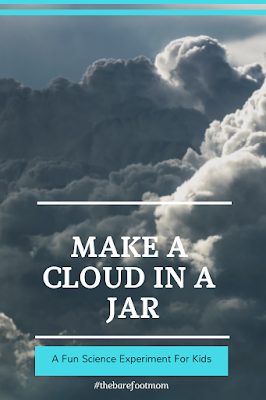We've been studying weather for a few weeks now, and this week we specifically learned about clouds. We looked at pictures and learned about different types of clouds. We watched a YouTube video about how clouds form. And today we made our own cloud in a jar in our kitchen!
In this post I'll share step by step instructions for making a cloud in a jar and explain how it works.
How to make a cloud in a jar:
For this experiment you will need:
-A glass jar
-A metal dish
-Ice cubes
-Hairspray
First, fill the metal dish with ice cubes and give it a few minutes until the metal dish is cold.
Once the dish is really cold, add about an inch of warm water to the glass jar. Then set the metal dish filled with ice cubes on top of the glass jar.
Give it a minute or two to build condensation on the side of the glass, then quickly remove the metal dish, spray a tiny amount of hair spray in the jar, and quickly replace the metal dish.
You should see a cloud begining to form at the top of the jar. Wait a minute or two for water vapor to build up and then remove the metal dish and watch your cloud slowly dissipate.
How it works:
Since the water in the jar is warm, some of it turns to water vapor and rises to the top of the jar, where it comes into contact with cold air from the ice. Water vapor condenses as it cools. For a cloud to form, it must have a surace to condense on. The hairspray acts like dust particles in the atmosphere, giving the water vapor a surface to condense on.
Extend the learning:
A few resources with good information about clouds for kids:
-Ducksters- The Water Cycle
-Ducksters- Weather and Clouds
-Science Videos For Kids- How Are Clouds Formed?
-FreeSchool- All About Clouds For Kids
If you enjoyed this post, check out:
-Make A Simple Home Weather Station
-The Naked Egg Experiment
Follow me on:
Facebook
Pinterest
Instagram
-Ducksters- The Water Cycle
-Ducksters- Weather and Clouds
-Science Videos For Kids- How Are Clouds Formed?
-FreeSchool- All About Clouds For Kids
If you enjoyed this post, check out:
-Make A Simple Home Weather Station
-The Naked Egg Experiment
Follow me on:






Going to do this with the grandkids. Sounds like a ton of fun and something we would have fun doing.
ReplyDeleteEnjoy :-)
DeleteHow cool! I love little science experiments I can do with the kids.
ReplyDeleteThanks,we're definitely science lovers too :-)
DeleteWe did this with 2L soda bottles, corks and a bicycle pump. Isn't science fun?!
ReplyDeleteNeat! I love science :-)
DeleteHow cool! You always have such interesting projects I want to try out with my kiddos! Thanks for sharing!
ReplyDeleteThanks for reading :-)
DeleteOh this looks like a fun activity, my daughter will love this!
ReplyDeleteThanks for reading! Hope your daughter enjoys :-)
DeleteSuch a cool idea!! My kids would love this!
ReplyDeleteThanks! My daughter loved this one :-)
Deletewhat a nice simple experiment.
ReplyDelete